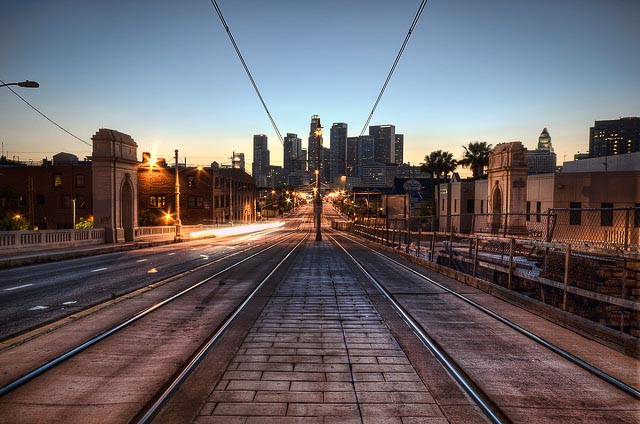Across the U.S. Sun Belt, cities that traditionally have been considered car-centric are starting to embrace light-rail and other forms of transit.
As the Kinder Institute's Bill Fulton and Kyle Shelton wrote back in September:
"What explains all this construction, especially in the traditionally auto-oriented South and West?
The short answer: Light-rail is a lot faster than a bus, but doesn’t cost nearly as much to build as a subway.
In many cities, the building of light-rail lines represents only one aspect of broader efforts to solve the public transportation puzzle. Cities are increasingly connecting light-rail lines with major nodes of activity and other transportation modes such as expanded express bus services or bike lanes."
Here’s a snapshot of some of the major Sun Belt transit projects that will hit either begin or end in 2016.
Los Angeles
Few cities anywhere have invested as much in their transit system in recent years as Los Angeles. And in 2016, commuters in the City of Angels will see fruit from those efforts in two major rail projects.
In early 2016, service is expected to begin on a nearly 7-mile extension of the Expo Line, the light-rail line that will connect downtown Los Angeles all the way to Santa Monica. The $1.5 billion project runs through the popular West Side and provides a viable commuting option in the congestion-choked city. The 46-minute rush hour trip only sounds long if you’ve never tried to drive it.
But that’s not the only major new stretch of rail opening in Los Angeles in 2016. The Foothill Gold Line currently runs from downtown Los Angeles through urban neighborhoods like Chinatown and Highland Park and eventually east to Pasadena. In March, riders will be able to take the line another 11.5 miles to Azusa in the San Gabriel Valley, an ethnically diverse and well-populated suburban area in the metro area. The line will eventually reach further East into the Inland Empire.
San Diego
The regional planning agency serving San Diego expects to begin construction by the end of 2016 on the area’s first major rail extension in 10 years. The Mid-Coast Trolley line would be the light-rail system’s first foray into the northern part of the city of San Diego, connecting the Old Town station to La Jolla and the University of California – San Diego, along the way putting three stations just east of the city’s main beach communities. The $1.7 billion project would connect to the existing Blue Line, meaning riders could then take a trip from the U.S.-Mexico border, through downtown San Diego, and into the regional employment center in La Jolla and University City. It’s expected to be completed 4 years after construction begins.
Phoenix
Come March, Phoenix area transit riders can take their city’s light rail system another 3 miles north thanks to the $300 million extension that adds three new stations along 19th Avenue, running parallel to the heavily congested I-17 freeway corridor. The extension serves an area where 14 percent of residents are transit-dependent, about double the rate of the country as a whole.
El Paso
El Paso got its first taste of a bus rapid transit system in 2014 with the opening of the 8.6-mile, $27.1 million Mesa route, a 22-stop line with signal priority and pre-board payment system (though notably lacking a dedicated bus right-of-way). In summer 2016, the city’s Brio BRT system will open its second route, a $35.5 million, 14.5 mile line with another 29 stations. The city is going all out with BRT, with plans to open a third route in 2017 and a fourth one in 2019.
Dallas
Dallas and its far-reaching light-rail system are adding two new stations this year with a 2.6-mile extension of the Blue Line, which stretches from suburbs on the eastern side of the city and into downtown heading south. The $240 million extension will connect the system to the University of North Texas-Dallas campus.
New Orleans
Cities around the country are increasingly looking to streetcar systems as a less-expensive transit options to subways – even if transportation experts think they’re better economic development engines than they are actual transit solutions. But New Orleans is one of the few cities that never removed its pre-automobile streetcars in the first place. Now, it’s expanding the legacy streetcar system, with the first phase of a new expansion. It’s installing 1.6 miles of track, along with six new stations and a complementary bike lane, set to open before the end of 2016.
Jacksonville
Just this month, Jacksonville unveiled the first leg of its new bus rapid transit system, which will eventually be a five-line system covering downtown and beyond. The downtown portion, along with the Green Line that serves the area’s northern corridor, opened this month. Downtown, the system features top-of-the-line BRT features such as ticket vending machines at stations, dedicated lanes, traffic signal priority, and queue jumps. On the Green Line, the system has relatively frequent 10-minute headways, uniquely branded bus stops, and transit priority at intersections. By the end of 2016, the system – dubbed the First Coast Flyer – will open a new southeast corridor line, while the last two legs are still in development.
Orlando
The Central Florida commuter line SunRail, opened in 2014, is breaking ground on a pair of expansions that will go 12 miles to the north and 17 miles to the south. Altogether the relatively high-speed, heavy-rail line connects stations in three counties to the central Orlando employment area, offering an alternative for those in the region with lengthy commutes.

